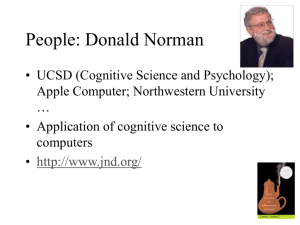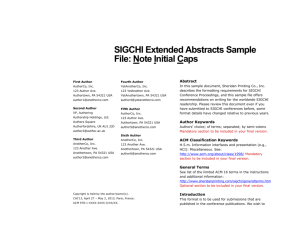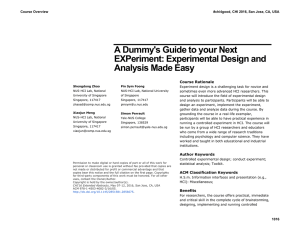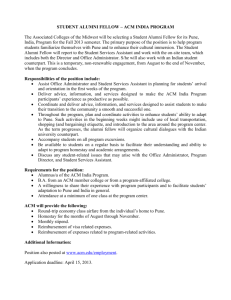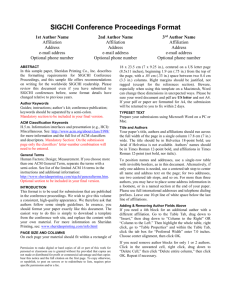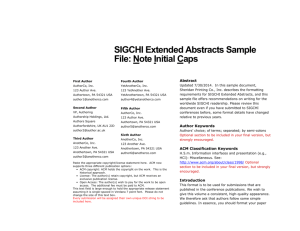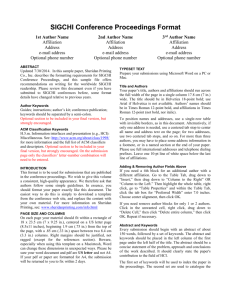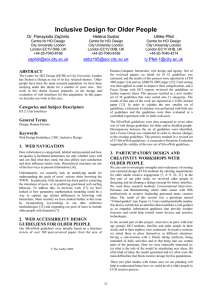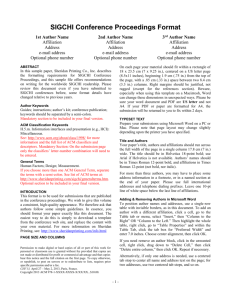Sketchpad
advertisement
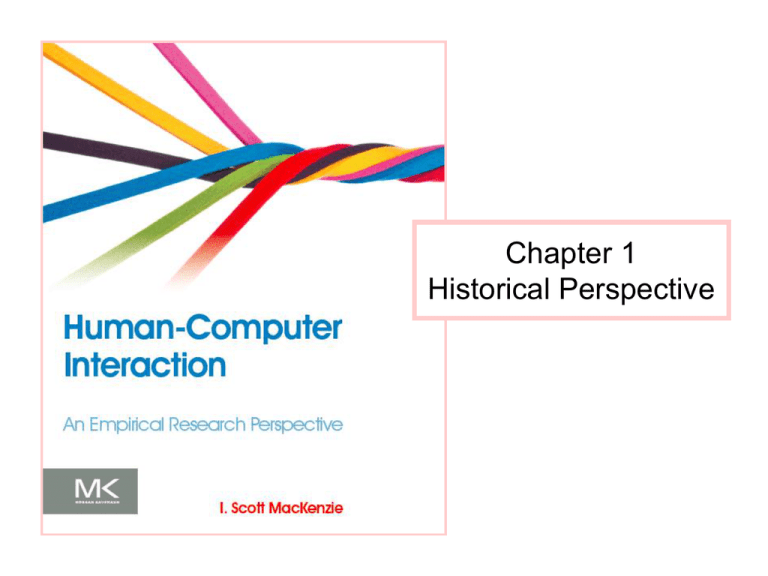
Chapter 1 Historical Perspective Significant Event Timeline 2 “As We May Think” Vannevar Bush (1945) 3 Reprinted in… Click here 4 Sketchpad Ivan Sutherland (1962) 5 Viewable on… Click here 6 Sketchpad: “Direct Manipulation” • Direct manipulation features: – – – – – – Visibility of objects Incremental action and rapid feedback Reversibility Exploration Syntactic correctness of all actions Replacing language with action • Term coined by Ben Shneiderman1 1 Shneiderman, B., Direct manipulation: A step beyond programming languages, in IEEE Computer, 1983, August, 57-69. Invention of the Mouse Doug Engelbart (1963) 8 Read About Doug Engelbart at… Click here Click here 9 HCI’s First User 1 Study A comparative evaluation of… 1 Mouse Joystick Lightpen Grafacon Knee-controlled lever English, W. K., Engelbart, D. C., & Berman, M. L. (1967). Display selection techniques for text manipulation. IEEE Transactions on Human Factors in Electronics, HFE-8(1), 5-15. Click here 10 Experiment Design • Participants: 13 • Independent variable – “Input method” with six levels: mouse, light pen, Grafacon, joystick (position-control), joystick (rate-control), knee-controlled lever • Dependent variables – Task completion time, error rate – (Note: task completion time = access time + motion time) • Within-subjects, counterbalanced • Task: – Press spacebar, acquire device, position cursor on target, select target 11 Results (1) Notes: 1 Access time with the knee-controlled lever was zero (since the device is always “acquired”). 2 Light pen use is fatiguing, since the user’s arm is held in the air in front of the display. 12 Results (2) 13 Xerox Star (1981) 14 Star GUI Icons 15 Birth of HCI - 1983 • Notable events: 1. First ACM SIGCHI conference (1983) 2. Publication of The Psychology of HumanComputer Interaction by Card, Moran, and Newell (1983) 3. Apple Macintosh announced via brochures (December, 1983) and launched (January, 1984) 16 ACM SIGCHI Mission The ACM Special Interest Group on Computer-Human Interaction is the world’s largest association of professionals who work in the research and practice of computer-human interaction. This interdisciplinary group is composed of computer scientists, software engineers, psychologists, interaction designers, graphic designers, sociologists, and anthropologists, just to name some of the domains whose special expertise come to bear in this area. They are brought together by a shared understanding that designing useful and usable technology is an interdisciplinary process, and believe that when done properly it has the power to transform persons’ lives. 17 SIGCHI Web Site Click here 18 SIGCHI Conference Publications 19 The Psychology of Human-Computer Interaction Card, Moran, and Newell (1983) 20 The Model Human Processor 21 Apple Macintosh (1984) 22 MacWrite Software 23 Apple Macintosh Commercial (1984) Click here 24 Apple Macintosh Timeline 25 Growth of HCI (1983-…) • Example of an early research topic – Breadth vs. depth in menu design 26 HCI Research • Research precedes products • Consider… • Two-finger gestures (Apple iPhone, 2007) • Acceleration-sensing (Nintendo Wiimote, 2005) • Wheel mouse (Microsoft Intellimouse, 1996) • Single-stroke text input (Palm’s Graffiti, 1995) • Were these ideas born out of engineering or design brilliance? Not really… 27 1 • Two-finger gestures: 2007? 1978 1 • Acceleration-sensing: 2005? 1998 2 • Wheel mouse: 1996? 1993 3 • Single-stroke text input: 1995? 1993 4 Herot, C. F., & Weinzapfel, G. (1978). One-point touch input of vector information for computer displays. Proc SIGGRAPH ‘78, 210-216, New York: ACM. 2 Harrison, B., Fishkin, K. P., Gujar, A., Mochon, C., & Want, R. (1998). Squeeze me, hold me, tilt me! An exploration of manipulative user interfaces. Proc CHI '98, 17-24, New York: ACM. 3 Venolia, D. (1993). Facile 3D manipulation. Proc CHI '93, 31-36, New York: ACM. 4 Goldberg, D., & Richardson, C. (1993). Touch-typing with a stylus. Proc CHI '93, 80-87, New York: ACM. 28 Resources Google Scholar: http://scholar.google.ca/ ACM Digital Library: http://portal.acm.org/ HCI Bibliography: http://hcibib.org/ Wikipedia: http://en.wikipedia.org/ Book web site: http://www.yorku.ca/mack/HCIbook 29 Thank You 30
